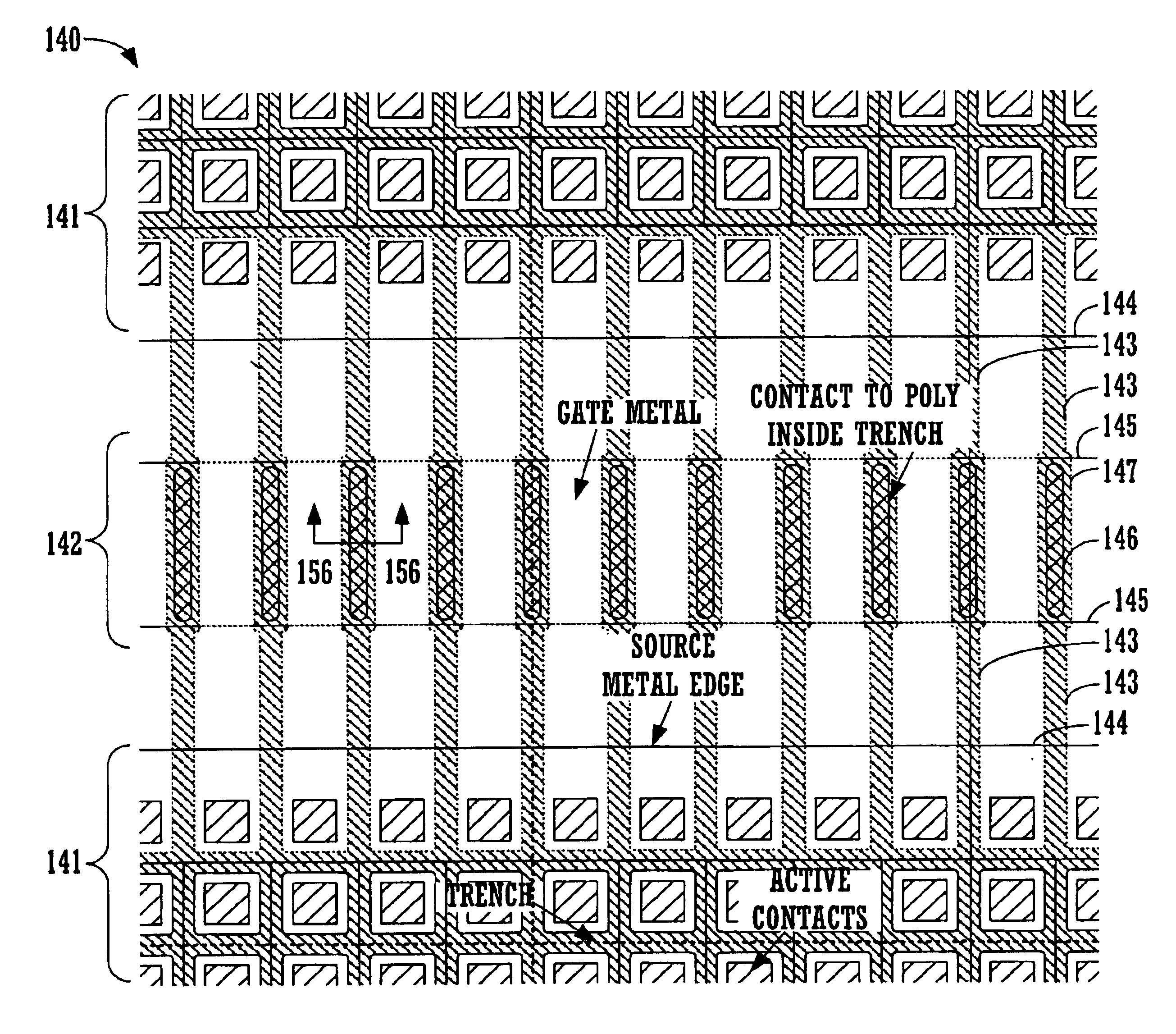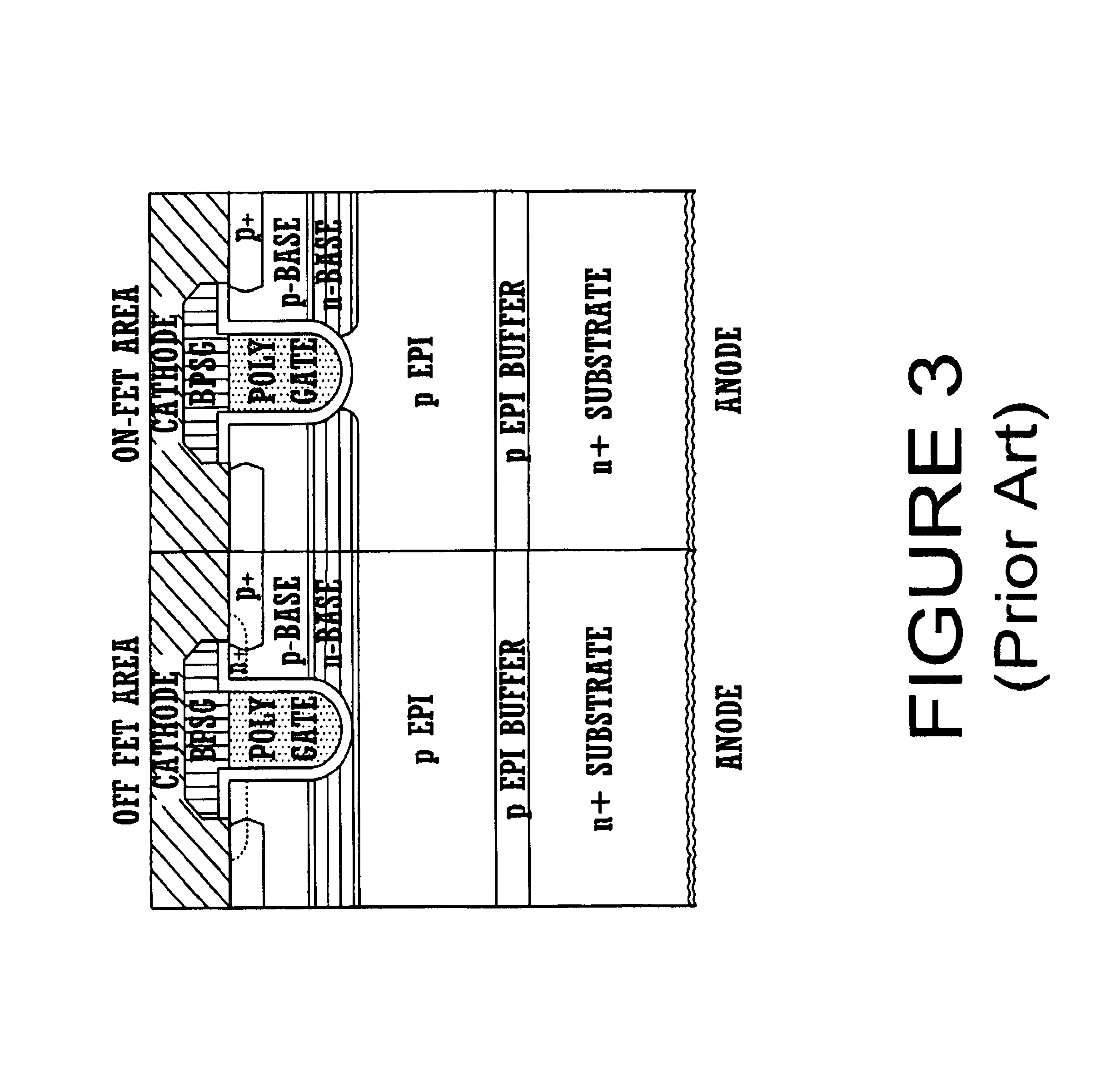Structures of and methods of fabricating trench-gated MIS devices
a technology of trench-gated mis devices and structures, which is applied in the direction of semiconductor devices, diodes, electrical apparatus, etc., can solve the problems of gate material extending outside, increasing current carrying capacity, and reducing device on-resistan
- Summary
- Abstract
- Description
- Claims
- Application Information
AI Technical Summary
Benefits of technology
Problems solved by technology
Method used
Image
Examples
first embodiment
FIG. 15A shows the invention. A square-celled MOSFET 140 includes an active region 141 and a gate metal region 142. A series of parallel gate fingers 143 extend from active region 141 into gate metal region 142. The edges of the source metal are designated 144; the edges of the gate metal are designated 145. Areas 146 designate the areas of contact between the polysilicon within gate fingers 143 and gate metal 145. It will be noted that gate fingers 143 expand into wide portions 147 to accommodate areas of contact 146. This allows for a good electrical contact to be made in the trench, spaced from the upper corners of the trench, even though the dimensions of the active cells become very small. FIG. 15C shows a cross-sectional view of one of the areas of contact 146 at cross-section 15C-15C, showing a gate metal 148 and a BPSG layer 149. FIG. 15B shows a top view of a portion of MOSFET 140 that adjoins a termination region 150 and a gate pad 151.
second embodiment
FIG. 16A shows the invention. MOSFET 160 contains an active region 161 and a gate metal region 162. The edge of the source metal is shown as 164 and the edge of gate metal 168 is shown as 165. A series of parallel gate fingers 163 extend from active region 161 into gate metal region 162. An area of contact 166 between the gate polysilicon and gate metal 168 is made in a gate finger 167 which extends perpendicular to gate fingers 163. In this embodiment, gate finger 167 is wider than gate fingers 163, but this need not be the case. FIG. 16C shows a detailed cross-sectional view taken at cross-section 16C-16C in FIG. 16A. FIG. 16B is a top view of MOSFET 160 in the vicinity of a termination region 170 and a gate pad 171.
There could be problems in filling the trench at the intersections between gate fingers 163 and gate finger 167, inasmuch as gate finger 167 is wider than gate fingers 163. This possible problem is illustrated in FIGS. 16C-16F. FIG. 16C is a detailed top view of the an...
third embodiment
This problem can be overcome in the third embodiment, shown in FIGS. 17A and 17B. MOSFET 180 is similar to MOSFET 160 shown in FIGS. 16A and 16B, except that gate fingers 183 are more widely spaced than gate fingers 163, and gate finger 187 becomes narrower at the intersections with gate fingers 183. Areas of contact 186 between the gate polysilicon and the gate metal do not extend into the areas where gate fingers 183 and 187 intersect. Thus the possible problem caused by the width of gate finger 187 at the intersections with gate fingers 183 is avoided. Of course, the spacing between gate fingers 183 is variable and need not be greater than the spacing between gate fingers 163 in MOSFET 160. FIG. 17B is a top view of MOSFET 180 in the vicinity of termination region 190 and gate pad 191.
PUM
 Login to View More
Login to View More Abstract
Description
Claims
Application Information
 Login to View More
Login to View More - R&D
- Intellectual Property
- Life Sciences
- Materials
- Tech Scout
- Unparalleled Data Quality
- Higher Quality Content
- 60% Fewer Hallucinations
Browse by: Latest US Patents, China's latest patents, Technical Efficacy Thesaurus, Application Domain, Technology Topic, Popular Technical Reports.
© 2025 PatSnap. All rights reserved.Legal|Privacy policy|Modern Slavery Act Transparency Statement|Sitemap|About US| Contact US: help@patsnap.com



